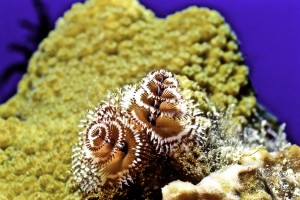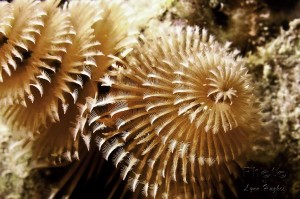Oh, Christmas Tree Worm!
When swimming over the reef, divers are often amazed to see what appear to be tiny, feathery Christmas trees growing out of many of the coral heads. These little tree-like objects are in fact a calcareous tube worm commonly known as the Christmas tree worm.
Christmas tree worms produce glue-like mucus which is mixed with fine sand to build a hard, calcareous tube to conceal and protect the worms’ body. The tubes are normally hidden in the reef substrate. Calcareous tube worms like the Christmas tree worm look more like flowers or trees than worms because, while their bodies are hidden from divers and snorkelers, their gill structures called crowns or radioles are extended from the end of the tube. Christmas tree worms have two spiraled gill crowns each one to one and one half inches tall.
These feather-like appendages act as both gills for respiration and to capture food in the form of plankton. There are a variety of crown colors and patterns, including black, gold, orange, pink, yellow, and multicolored. The worm’s mouth is at the center of the feathery crown. The calcareous tube worm uses an operculum similar to that of snails to cover its tube opening when the gill structure is retracted.
Many new underwater photographers have learned that tube worms can instantly retract their gill structures if disturbed by either movement or changes in light intensity. This phenomenon can be witnessed when a diver waves his hand over the gills or in some cases when a diver’s shadow covers the worm tube. Frustrated photographers will find that with a little patience, the crowns will slowly extend and reopen after a few seconds.
Christmas tree worms are abundant on all areas of the reefs in the Caribbean, the Bahamas, and Florida. When next cruising over the reef, take a close look at these tiny tube worms inhabiting the coral heads and ruble. They definitely enhance the beauty of our underwater world.
By
Lynn Hughes


